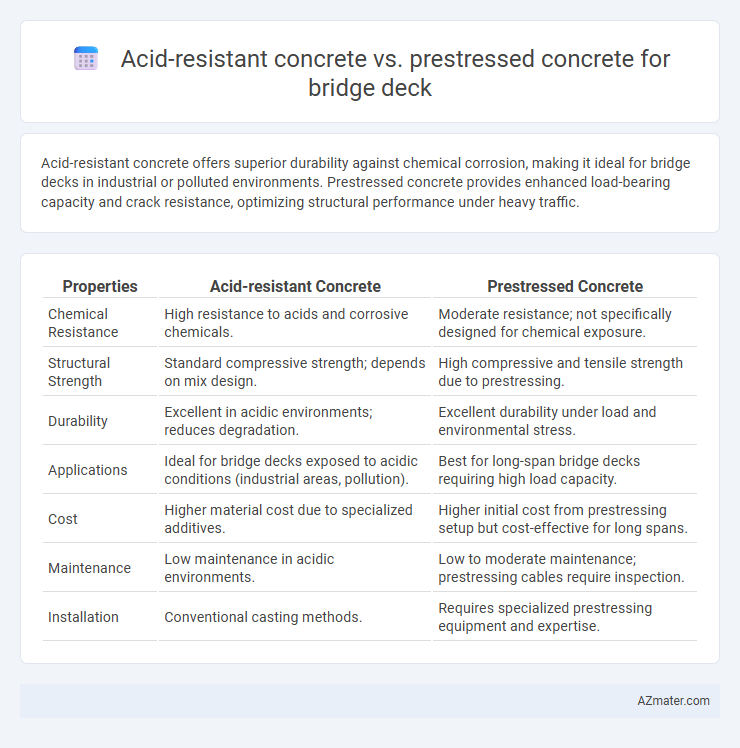Acid-resistant concrete offers superior durability against chemical corrosion, making it ideal for bridge decks in industrial or polluted environments. Prestressed concrete provides enhanced load-bearing capacity and crack resistance, optimizing structural performance under heavy traffic.
Table of Comparison
| Properties | Acid-resistant Concrete | Prestressed Concrete |
|---|---|---|
| Chemical Resistance | High resistance to acids and corrosive chemicals. | Moderate resistance; not specifically designed for chemical exposure. |
| Structural Strength | Standard compressive strength; depends on mix design. | High compressive and tensile strength due to prestressing. |
| Durability | Excellent in acidic environments; reduces degradation. | Excellent durability under load and environmental stress. |
| Applications | Ideal for bridge decks exposed to acidic conditions (industrial areas, pollution). | Best for long-span bridge decks requiring high load capacity. |
| Cost | Higher material cost due to specialized additives. | Higher initial cost from prestressing setup but cost-effective for long spans. |
| Maintenance | Low maintenance in acidic environments. | Low to moderate maintenance; prestressing cables require inspection. |
| Installation | Conventional casting methods. | Requires specialized prestressing equipment and expertise. |
Introduction to Bridge Deck Materials
Acid-resistant concrete is engineered to withstand corrosive environments, making it ideal for bridge decks exposed to industrial pollutants or acidic rain, prolonging structural durability. Prestressed concrete uses high-tension steel strands to enhance load-bearing capacity and minimize cracking, offering superior strength for heavy traffic and dynamic loads. Both materials address durability but differ in chemical resistance and mechanical reinforcement suited for specific bridge deck conditions.
Overview of Acid-Resistant Concrete
Acid-resistant concrete is specifically designed to withstand aggressive chemical environments, making it ideal for bridge decks exposed to acidic rain or industrial pollutants. This type of concrete incorporates special binders, such as silica fume or fly ash, and non-corrosive aggregates to enhance durability and prevent structural degradation. Its superior resistance to acid attack reduces maintenance costs and extends the service life of bridge decks in harsh environments.
Understanding Prestressed Concrete
Prestressed concrete incorporates high-strength steel tendons tensioned before concrete placement to enhance load-bearing capacity and reduce tensile stresses in bridge decks, providing superior durability and crack resistance compared to acid-resistant concrete. Acid-resistant concrete is specifically formulated to withstand corrosive environments but may lack the structural performance benefits of prestressed designs. Selecting prestressed concrete for bridge decks ensures improved structural efficiency and longevity, especially under heavy traffic and dynamic loads.
Key Composition Differences
Acid-resistant concrete for bridge decks incorporates high proportions of silica fume, low calcium aluminate cement, and chemical admixtures to enhance chemical durability and resist acidic environments. Prestressed concrete, by contrast, utilizes high-strength cement, low water-cement ratio, and embedded steel tendons tensioned before loading to provide enhanced structural capacity and crack control. The essential distinction lies in acid-resistant concrete's focus on chemical composition for durability, while prestressed concrete emphasizes reinforcement techniques for superior mechanical performance.
Durability in Harsh Environments
Acid-resistant concrete offers superior durability for bridge decks exposed to corrosive environments by incorporating specialized aggregates and chemical admixtures that resist acid attack, significantly reducing surface degradation and extending service life. Prestressed concrete enhances structural performance through tensioned reinforcement, improving crack control but remains vulnerable to chemical deterioration if not adequately protected from acidic exposure. For harsh environmental conditions, acid-resistant concrete provides enhanced longevity and maintenance reduction, while prestressed concrete benefits from combining with protective coatings to maintain durability.
Resistance to Chemical and Environmental Attacks
Acid-resistant concrete for bridge decks offers superior protection against chemical attacks from acidic rain, sulfates, and industrial pollutants due to its specialized low-permeability mix and use of acid-resistant aggregates. Prestressed concrete, while providing high structural strength and durability under mechanical loads, may be vulnerable to chemical degradation if not properly sealed or coated, as prestressing steel can corrode when exposed to aggressive environments. Selecting acid-resistant concrete enhances long-term performance in chemically harsh conditions, reducing maintenance costs and prolonging service life of bridge decks.
Load-Bearing and Structural Performance
Acid-resistant concrete offers excellent durability against chemical attacks, making it ideal for bridge decks exposed to harsh environments, but its load-bearing capacity typically falls below that of prestressed concrete. Prestressed concrete enhances structural performance by introducing compressive stresses, allowing it to support higher tensile loads and longer spans with reduced cracking and deflection. Load-bearing efficiency in prestressed concrete leads to thinner bridge decks with longer service life, whereas acid-resistant concrete prioritizes chemical resistance, potentially requiring thicker sections to achieve comparable strength.
Maintenance Requirements and Lifecycle
Acid-resistant concrete offers superior durability against chemical attack, significantly reducing maintenance frequency and costs for bridge decks exposed to harsh environments like industrial areas or coastal regions. Prestressed concrete enhances structural performance by minimizing cracking and deflection, which lowers routine repair needs and extends the bridge deck's service life under heavy traffic loads. Combining acid resistance with prestressing techniques optimizes lifecycle performance, balancing chemical durability with mechanical strength to reduce long-term maintenance and improve overall durability.
Cost Comparison and Economic Considerations
Acid-resistant concrete offers superior durability and requires less maintenance in aggressive environments, resulting in lower life-cycle costs despite a higher initial price compared to prestressed concrete. Prestressed concrete, typically more economical upfront, may incur increased repair and replacement expenses due to susceptibility to acid-related deterioration. Economic considerations should emphasize long-term performance and maintenance savings, where acid-resistant concrete presents a cost-effective solution for extending bridge deck lifespan under corrosive conditions.
Selecting the Optimal Material for Bridge Decks
Acid-resistant concrete offers enhanced durability in corrosive environments, making it ideal for bridge decks exposed to chemical pollutants or acidic rain. Prestressed concrete provides superior load-bearing capacity and crack resistance, ensuring long spans and reduced maintenance under heavy traffic conditions. Selecting the optimal material depends on environmental exposure, structural demands, and lifecycle cost analysis to maximize bridge deck performance and longevity.

Infographic: Acid-resistant concrete vs Prestressed concrete for Bridge deck
 azmater.com
azmater.com